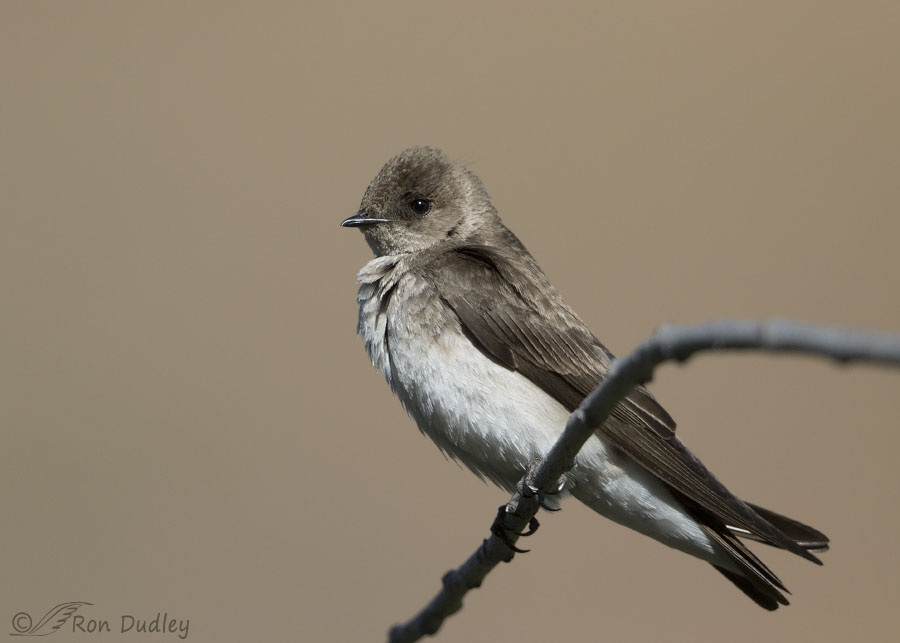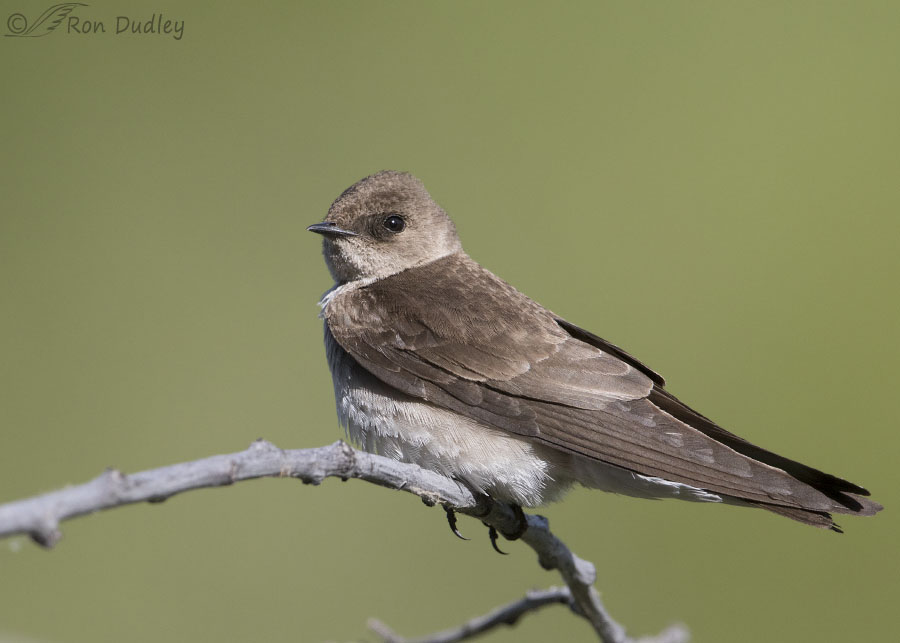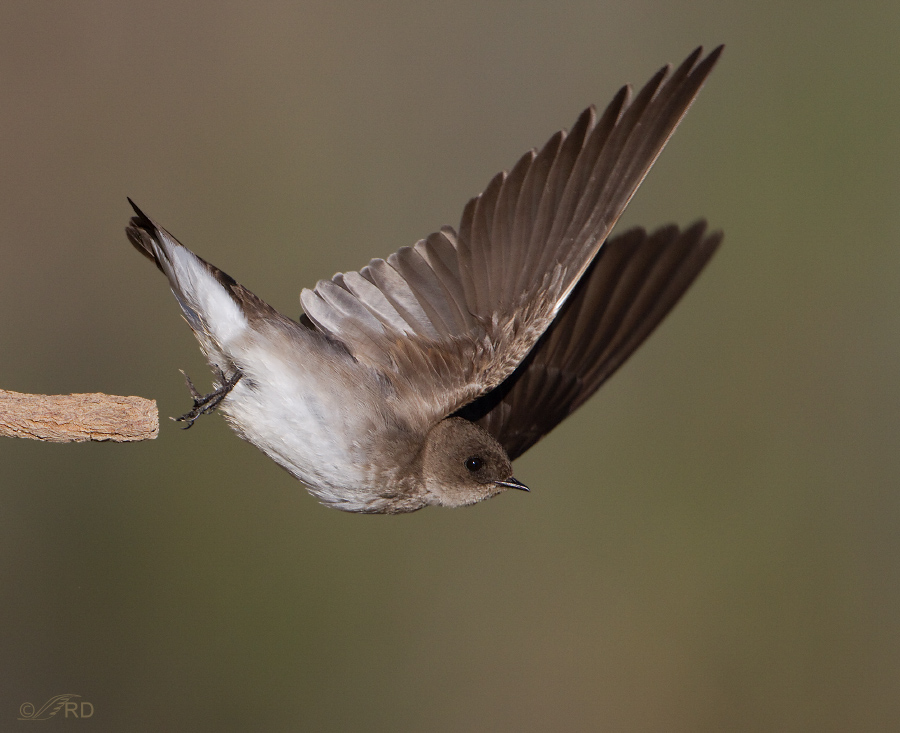Have you ever wondered how this swallow acquired such an unusual name? Where did “rough-winged” come from?

1/4000, f/6.3, ISO 640, Canon 7D Mark II, Canon EF 500mm f/4L IS II USM + EF 1.4 III Extender, not baited, set up or called in
Eight days ago in the Wasatch Mountains I was waiting for a hummingbird to show up on his favorite perch when 2 Northern Rough-winged Swallows magically appeared out of nowhere and landed very close to me on a couple of apparently dead branches in a nearby tree. This was one of those birds.
They were both close and I have good detail and clean backgrounds with each of them but I’m not happy with the out-of-focus perch in front of this one.

1/2500, f/6.3, ISO 640, Canon 7D Mark II, Canon EF 500mm f/4L IS II USM + EF 1.4 III Extender, not baited, set up or called in
I like this shot better because the perch isn’t in front of the swallow. I very seldom see this species and I believe I’ve only photographed them once before so I was happy they made an appearance.
I’ve often wondered how Northern Rough-winged Swallows acquired such an unusual name so this time I decided to do a little research. I’ll try to explain it below but doing it well won’t be easy because the feature is too small to see in my photos and I couldn’t find an illustration or photo that I could legally copy or even link to. I think you’ll need to already know some basic feather anatomy to completely understand it but let’s give it a shot anyway…
- The tiny stiff barbs of the leading edge of their outer primary wing feathers lack terminal barbules between them on their ends so the barb ends stick out all by themselves. In males those “pointy things” are recurved into tiny hooks but in females they’re much straighter so they’re simply pointed. As a result, in males when humans draw their finger along the edge of the feather we feel the file-like roughness of those hooked barb ends. When early taxonomists had these birds in hand they were so taken with this characteristic that they referred to it twice when assigning a scientific name to the species – their genus name Stelgidopteryx means “scraper wing” and their species name serripennis means “saw feather”.
To this day the presumed function of this unusual feature remains a mystery to science.
Ron
Addendum: This photo was taken a few years ago on the only other occasion when I remember ever photographing this species. This bird and a few others were nesting in a mud bank along the Jordan River.



Phenomenal photos!
Thanks for explaining the name. It certainly seems like naming a bird for a dead specimen creates names which are not apparent in the field. Group this name with Ring Necked Duck.
Very nice detailed images, Ron! Ever since learning about how they received their name, I’ve been trying to get some sort of photograph showing the feature. Of course, first, find one. Then, get one to hold still. Then take a perfect photo.
Needless to say, my quest continues ….
Wally, I was quite close to these birds and I had good detail so I went to 100% on a few of the images to see if I could see it. I might have been able to – barely, or maybe not. Hard to tell for sure. BNA says it can’t be seen even with a bird in the hand – but it’s easy to feel if you run your finger along the feather.
Like Marty I am endlessly grateful to learn. And to learn such fascinating snippets too.
Love the launch shot in particular.
Megathanks.
Thank you, EC.
Very interesting. I wonder if I have seen them and thought they were a juvenile.
April, I suspect I’ve seen many more of them than I’ve recognized – especially when they’re in flight.
Yay! Another LBJ to “ooh and ahh” over! I really like the second shot with the green behind the bird and that third shot is amazing! And of course, thanks for another interesting lesson, Teech! I love learning something new before 9 a.m.
I’m glad at least some folks appreciate those “lessons”, Marty. I’m sure they don’t appeal to everyone but that’s ok…
Love these birds!! And the photos are great! The first time I saw one was last year in the spring – just one little guy was sitting on tree limb above me. He must have been molting because his feathers looked bedraggled and messy. But I just figured that’s why they called ’em Rough Winged. Duh!
 Us new birders are a “hoot”.
Us new birders are a “hoot”.
Thanks, Muffy. Actually they get their name from something else. I’ve explained it in my text.
Very interesting Ron. Thanks for the education on these swallows. I really like the last photo, of the swallow flying from the branch, the best. They are so beautiful, yet we rarely get to see how much so since they are flying so fast and we only get fleeting glimpses. Your photos really show their beauty!
Thanks, Ed. I worked hard getting that takeoff shot so I was pretty happy with it too. That perch is the root of a tree sticking out of the mud of the vertical river bank. Don’t know why the end of it looks cut off. I have no idea how anyone could get to it to do it.
I had never heard of Rough-winged Swallows before reading the title for this post. I looked them up in Sibley and was surprised to see that their summer range includes all of the lower 48 states. They are beautiful birds – I like their monochromatic coloring a lot. I agree that the out of focus perch in the first shot is annoying, but it’s still a beautiful portrait of this bird.
“I like their monochromatic coloring a lot”
I do too, Susan. I think it’s rather dashing in a subtle sort of way.
With birds there will always be limbs, branches, and leaves – but great photos of one of my favorites. We have huge numbers of them here by a couple of our lakes. Never knew what they were till we moved here. One morning a few years back I came around a bend at Willow Lake and right in front of me in a dead tree were fifty or more of them just sitting there resting. Thanks for the information and photos Ron.
Everett Sanborn
Prescott AZ
It’s funny, Everett. From the comments here and elsewhere some folks see them all the time and others never do, even though their range includes the entire lower 48.
Interesting bird and facts! Your pictures make the little one very appealing, especially the catch-lights. I find the names of birds fascinating. The latin I took in high school has remained with me in both of my careers…as a nurse and horticulturist. Once you know it, it’s there forever and you can figure out so many of the technical names from that.
I know this is a bird I have not seen. Checking with ‘e-bird’ I found it was sited at a site for a potential landfill but never used not far from my home…(dug out cells and filled with water). Also there were many sitings along Lake Michigan…so long story short I’m going to have to spend a day trying to find the little one….more info than you cared to know!
I always “care to know” stuff like that, Kathy. I wish you luck finding them.
Different for sure – you’d think the rough edges would interfere with flight to some extent? I’ve not heard of the bird or, to my knowledge, ever seen one – a LBJ type bird it seems……..;)
Judy, I’m surprised I don’t see (or notice) them more often. They’re fairly common throughout North America south of Canada but I very rarely encounter them. Of all of the native swallow species this one is reported (by bird surveys and others) much less often than all the others.